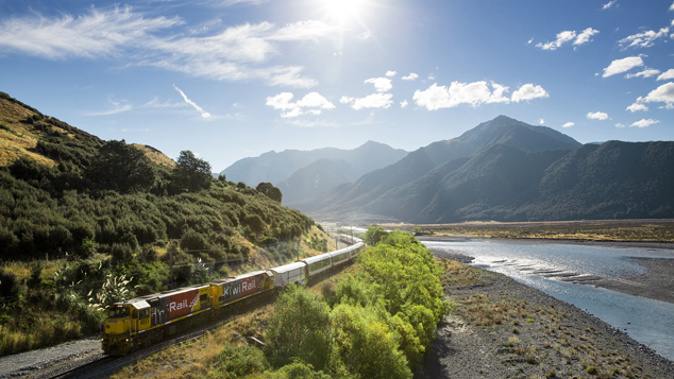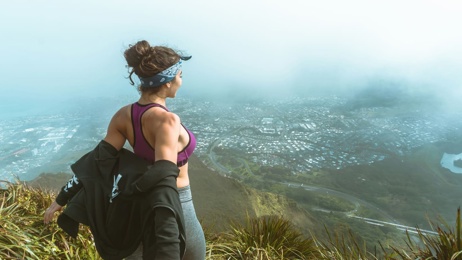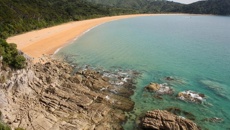
When was the last time you answered the blowing whistle of the TranzAlpine train for an iconic ride through the Southern Alps from Christchurch? I recently boarded the excursion, where urban sprawl soon gives way to the sprawling pastoral quilt of the Canterbury Plains, which are deceptively not as flat as you may think. By the time you reach Springfield, at the western edge of the plains, you’re 400 metres above level. Bathed in pale winter sun, while broad bands of storm clouds loomed large on the western horizon, I was gleaning insights about the radical transformation of the Canterbury Plains, as you chug across this cultivated, heavily-farmed checkerboard.
TranzAlpine has enhanced their audio commentary substantially, scrapping the intrusive narration on the public address system. Instead, a comprehensive commentary is delivered to your seat, via plug-in headphones, providing fascinating factoids about the passing terrain. Previously covered in podocarp forest, including totara and kahikatea trees, today only 0.5% of the Canterbury Plains features native vegetation, making it the most ecologically altered area in New Zealand.
Alongside sheep and dairy farming, the plains still produce the bulk of New Zealand’s wheat, oats, barley and peas. As we approached Springfield, tussocked foothills and snow-speckled peaks necklaced the horizon, including the photogenic Torlesse Range, and to its left, the ski mecca of Mt. Hutt. Entering the high country, the next 30 minutes of the trip is like a rolling photoshoot of riveting scenery, as the train plays peek-a-boo with the upper reaches and granite ravines of the ice-fed Waimakariri River, replete with tunnels, bridges and impressive aqueducts, all the way to Cass.
Hugging the hillside, cutting through the raw scenery, I braved the frigid air to marvel at the natural splendour from the open-air observation carriage. I struck up a camera-clicking rapport with an intrepid Queenslander, who didn’t seem the slightest bit bothered by the bone-chilling, wind-lashed body exfoliation. Despite the assault of the elements, we concurred that photos without the impediment of glass, in this part of the world, are simply priceless.
Steadily climbing into the tussock-cloaked high country, pristine alpine lakes and snow-dappled peaks like the Craigieburns, Mt. Binser and Mt. Wilson compete for your affections. Entering the celestial heights of the Southern Alps, we had a whistle-stop break at the snoozy alpine hamlet of Arthur’s Pass, where the wind-chill was positively polar. Mighty Mt. Rolleston and Mt. Temple were cloaked in fresh snow.
Tootling into the cleavage of the Main Divide, the train then plunges into the 8.5km long darkness of the Otira Tunnel. With a profoundly steep gradient of 1 in 33, it remains one of New Zealand’s finest engineering feats. In fact, when the tunnel finally opened in 1923, after 15 years of back-breaking toil through the tough granite rock, it was the longest rail tunnel in the British Empire. Emerging back into daylight by the characterful Otira Hotel and the clutch of rustic West Coast railway houses, more monumental mountains beckon as potential money shots, like the majestic Alexander Range.
Back out in the observation car, the forest finery carpeting the mountains is noticeably different to the eastern side of Arthur’s Pass. To the east, native mountain beech is the dominant species, yet to the west, ancient podocarp rainforest thrives in the warmer, wetter climate, thick with rimu, matai and kahikatea. The train wended its way through the Taramakau Valley with lovely views of the historic Jackson’s Tavern, which began life as a Cobb & Co stop in 1861. Veering right, we passed by glittering Lake Brunner, before snaking through the stunningly picturesque Arnold Valley and Grey Valley. I instagrammed my heart out in these valleys, where the sheer spectrum of vivid green hues would give the Emerald Isle a run for its money.
On final approach to Greymouth, we ambled through the storied settlement of Dobson, one of New Zealand’s early coal mining sites. The town is named for the surveyor George Dobson, who was murdered here in 1866, in a bungled robbery by a gang who had mistaken him for a gold buyer. George was an intrepid bush-tracker, sizing up routes between Canterbury and West Coast. He was the brother of Sir Arthur Dobson, who led the first Europeans across Arthur’s Pass in 1864. A monument now stands where George was killed.
Across the silvery slithering Grey River, silence now hangs over the vast remains of what was once one of New Zealand’s most productive coalmines, linked by an impressive 1876 suspension bridge. Thomas Brunner discovered coal here in the 1840s. By the 1880s the Brunner mine was producing more coal than any other in New Zealand and tragically experienced our country’s greatest mining tragedy in 1896 when 65 workers died following an explosion. They are sobering reminders of the rugged and dangerous exploits that built the West Coast, as the train ushers you arrive into Greymouth.
The TranzAlpine, is truly a signature New Zealand experience, traversing the sublime heights of the Southern Alps, pastoral plains, alpine lakes and lush rainforest. The 233km rail journey is four hours in length each way. The purpose-built carriages, designed and constructed in New Zealand, offer a swirl of comforts and amenities including power points, digital screens and headset-commentary, plus a licensed dining carriage brimming with tasty eats and drinks. For further details and bookings, head to www.kiwirailscenic.co.nz
Extend your stay in the wonderful West Coast with a bumper self-drive winter escape. Thrifty Car Rental offers hot deals, swift service and an excellent fleet in handy locations, including Greymouth Railway Station. Become a Blue Chip member for great deals and lightning-fast pick-ups. www.thrifty.co.nz
Just five minutes from Greymouth Railway Station, on the southern approach to the town centre, The Ashley Hotel Greymouth contains all the ingredients for the ideal overnight roost. Need a hot soak? The Ashley features an on-site spa pool and small fitness centre. Accommodations are a haven of comfort, generously-sized, with flat-screen TVs, Sky channels and free WiFi. If you’re planning a longer-stay, opt for a studio or apartment, with full kitchen facilities. On-site dining is highly recommended at Jacob's Grill and the Club Bar. You can dine in the restaurant or dial up room service, for extra decadence. You can also make use of the guest laundry and enjoy off-street parking. www.williamshotels.co.nz/ashley-hotel-greymouth
Mike Yardley is Newstalk ZB’s Travel Correspondent on Saturday Mornings with Jack Tame.
Take your Radio, Podcasts and Music with you









